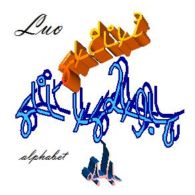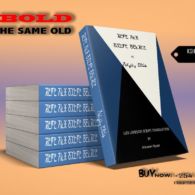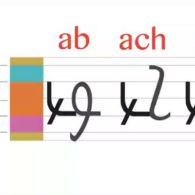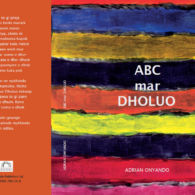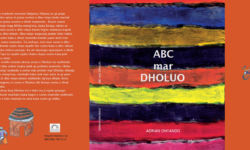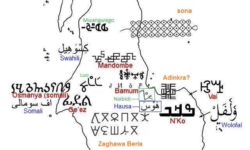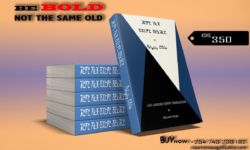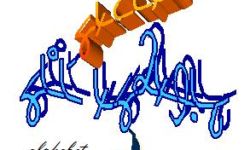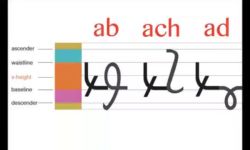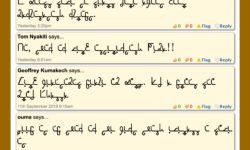Profile
The Luo Lakeside Script was developed by Kefa Ombewa in Kenya with help from graphic designer Will Were and Paul Sidandi of Botswana between 2009 and 2012 as a unique, non-Latin way to write the Dholuo language – so as to, in Ombewa’s word, decolonise African culture: “I was interested in making sure that African societies, and in this case particularly Luo, also have their own script.”
Creating a workable non-Latin script turned out to involve a wide range of challenges. How would the glyphs work together with a QWERTY keyboard? Would it be possible to make similar sounds look the same when written?
These questions go to the heart of writing. What is functional in terms of symbol-to-sound correspondence? What is functional in terms of the human body itself, and the physical act of writing? How do these fundamentals combine with what one’s culture sees as attractive, as writing-like, whatever that is?
“Through trial and error, samples of simple abstract strokes and curves were used,” Ombewa said. “Further modifications were done in order to fit specifications of font creator softwares.”
Developing a new script in an era of digitisation presents opportunities as well as problems. Dozens of newly created scripts around the world are in a kind of pre-digital limbo, waiting for someone with a new and unusual combination of skills – linguist, typographer, coder—to take them along the tedious and arduous road into Unicode. Interestingly, many newly developed scripts still use features of handwriting. The guiding principle for Luo, Ombewa explained, was to develop a cursive script with a central connection, having ascenders and descenders.
At the same time Paul Sidandi, working independently from Francistown in Botswana, was developing an African number system known as Luo numbers. (It was later changed to Luo Numerals to avoid confusion with Chinese, who also have Luo Numbers). The alphabet and numbers were combined to form the Luo Lakeside Script, and designer Will Were joined the project in order to produce a true-type font of the script. The work was completed in 2012.
“Africans generally learn to write letters in the air, then on the ground,” Paul Sidandi explained. “This is the logic for the horizontal line which can be seen running through the letters and numbers when written sequentially.”
As always, the challenge facing a new script was partly invention, but mostly acceptance and implementation. It was publicly launched by Kefa Ombewa in an interview on the Kenya Television Network in 2014, after which an implementation team was set up with representatives from Botswana, Kenya, Australia, the UK, Tanzania and Uganda.
In Botswana, graphics designer Taolo Dipatane of Lobatse was tasked with producing infographics and designs for posters, clocks and T-shirts. The team pitched the script to local chiefs, magistrates, academics, youth groups, museums, schools and sign-language interpreters.
The script has been tested in several primary and junior secondary schools around Botswana; and in Kenya, an academy has made a commitment for the script to be taught at the school. The script has also been presented at the Museums of Botswana, University of Botswana Mathematics Department and the Botswana International University of Science and Technology.
Maureen Oyuga’s book of Luo words, written in the Lakeside script and translated into English, has sold nearly a thousand copies. But as with many recently created indigenous African scripts, the aim is to make it continental rather than national, and keyboard developments mean that the script can now be used by any African language, ranging from Akan of Ghana to Zulu of South Africa.
“I want to make it an African script,” Ombewa said. “If the Luo want to enjoy the script and own it, I don’t mind, but it is an African script. I envision an Africa that is delatinised all the way from West Africa to East Africa.”
—Edited and updated by Eddie Tolmie.
You can help support our research, education and advocacy work. Please consider making a donation today.
Links
General Script, Language, and Culture Resources
- Omniglot
- Wikipedia
- Kefa Ombewa Youtube Channel
- Wikipedia (Luo Languages)
- Wikipedia (Luo People)
- Scriptsource
- Decolonizing Luo Language Interview
- Cultural Background Video
